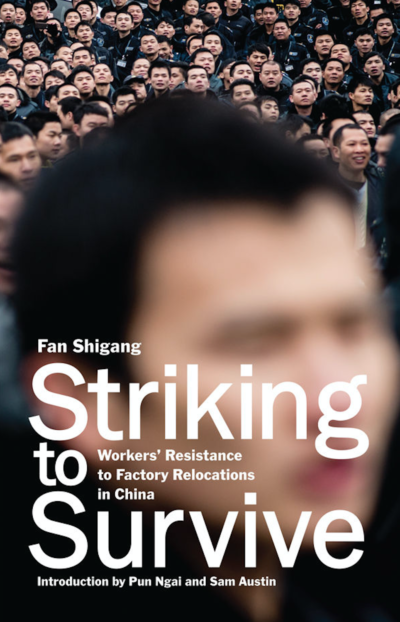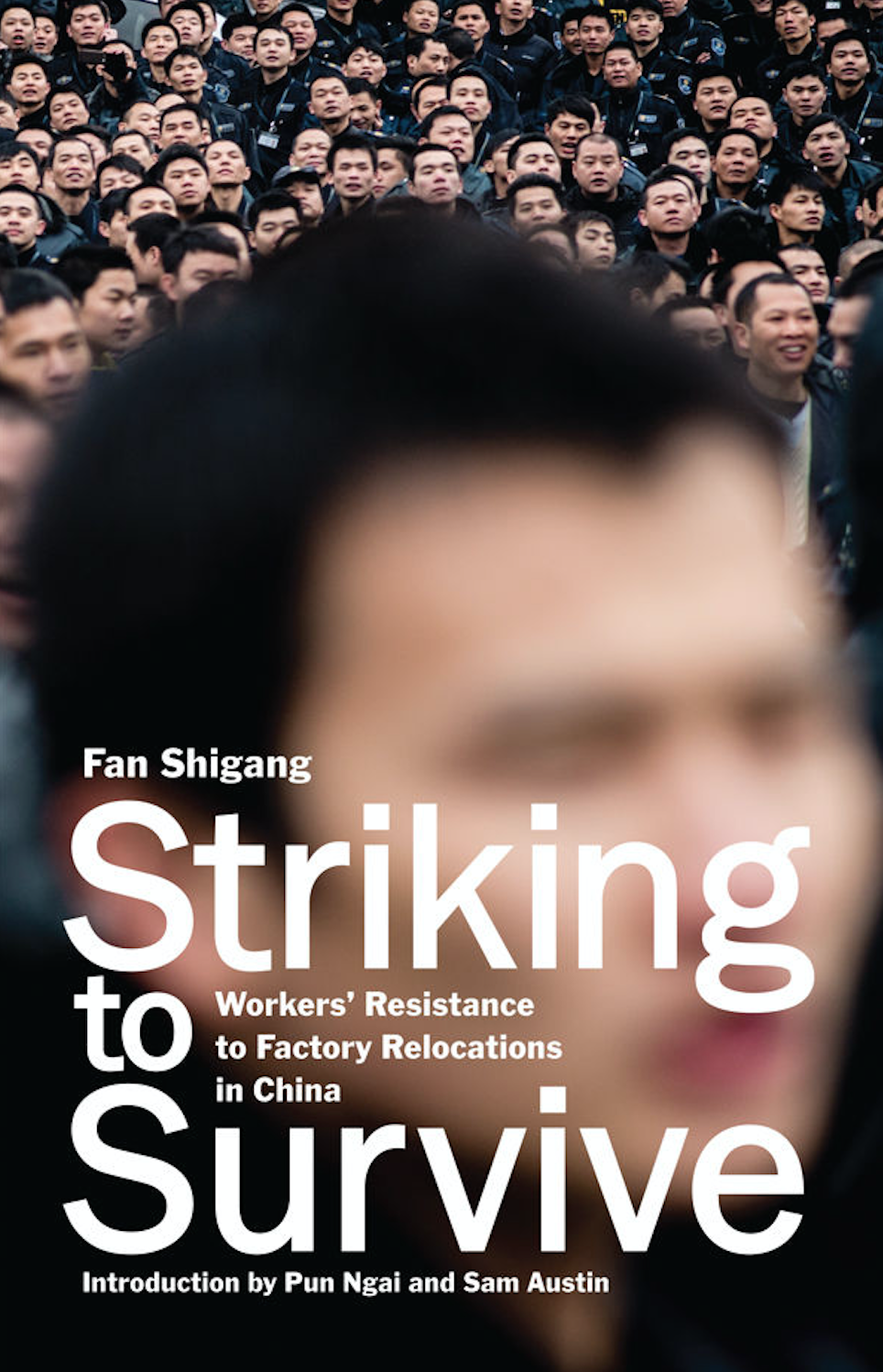This article was originally published at Labor Notes.

China has more strikes per year than any other country, many thousands. These strikes are often unplanned, spontaneous, even chaotic, and the bosses stop at nothing to suppress them: they lie, cheat, call in the police, and hire gangsters to intimidate strikers or even beat them up.
But the strikes keep happening—especially when it becomes clear, usually by the removal of machinery, that the owner is relocating the factory. These frequent relocations have one main cause: employers are moving to regions of China where the wages are lower.
Fan Shigang’s new book Striking to Survive gives workers’ oral histories of three strikes between 2012 and 2016 in the Pearl River Delta, also known as “the workshop of the world.” Workers in that region, Shigang writes, have finally dug in their heels.
One strike was against a factory that supplied furniture to Walmart; two were against a supplier of the hip Japanese clothing corporation Uniqlo. In both factories the workers struck to stop relocations, although the Uniqlo supplier workers also walked out over pensions and housing funds.
But one thing becomes clear when reading about their grievances and working conditions: they had plenty of genuine complaints long before relocation became an issue.
Many workers put in 12-hour days, six days a week—sometimes even seven days a week. Many had the cost of inedible cafeteria food deducted from their pay. Most did not receive mandatory pension contributions from their boss.
Factory discipline was enforced with cameras and fines. Taking a day off led to firing or a fine. Minor infractions were fined. And once the workers actually struck, their elected delegates were arrested, while the workers themselves were assaulted.
As one worker said, “we didn’t trust the government because they had already lied to us many times.” Indeed, government policy supports the owners.
According to the book’s introduction, these strikes belong to the third wave of strikes in China—and were less successful for various reasons, such as that they had mainly to do with relocations. In the earlier two waves, the workers had more hope of improving their workplace conditions.
Many of the strikers in this third wave were older than the strikers in the first two, and their grievances differed: “Whereas the first round was largely centered on wage arrears, and the second expanded to add demands such as wage raises and even union reform, this third round centered on demands for severance pay and Social Insurance.”
Holding Out For Weeks
The Walmart supplier struggle began when the workers prevented a truck from hauling machinery to the new factory. It lasted weeks. Workers were beaten and seized by police.
During the strike, the owners enraged the workers by publicly repeating the sayings, “It’s worth ten million yuan to break the workers,” and “I’d rather see the money in the river than in their hands.”
The workers succumbed to police and management pressure to elect delegates—which they did reluctantly, having heard of management buying off and coopting delegates in other strikes. Their most effective, eloquent, and trustworthy delegate, Mr. Wu, was arrested and jailed for six months.
After the workers blocked the departure of the trucks moving machinery, the owner began to negotiate—whereupon the government and the owner said, “See, we’re negotiating, now release the truck.” Unfortunately the workers fell into this trap and let the truck go. The negotiations immediately foundered, the boss stopped showing up, and the relocation continued.
This strike makes clear that without organization and solidarity, a strike cannot succeed. When the bosses and government officials promised relocation would not occur, the workers recognized the lies and at first did not capitulate. Nonetheless, according to Mr. Wu, “beneath the surface, things were bad. The workers were not united, nor were the workers’ delegates. The boss divided us and broke us…. As time went on, the workers became impatient and impulsive.” And the workers’ delegates had to plan to hide, once they and everyone else had been compensated.
“When it is all over,” Shigang writes, “They will not discuss the terror they felt, nor will they mention the intense hatred they harbor for the bosses.”
Sad Endings
In 2005 the Uniqlo supplier employed 3,000 workers at its factory in the Pearl River Delta. By December 2014, the workforce had shrunk to 800. Most were women, Shigang reports, and many had been there over a decade.
At the start of the first strike there, which was over unpaid pension and housing funds, “the workers locked up the factory.” One woman characterized the strike as an “uprising” and as a “riot.” A labor NGO helped them organize. On the ninth day, Shigang reports, “the boss personally brought a great number of riot police to force the workers back to the shop floor.”
The boss won a second strike over relocation pay, according to Shigang, with several tactics: all the important machinery had already been relocated; combative male workers had already been dealt with; the police kidnapped a female worker, who became their “hostage”; management tricked over 400 workers into going to the new factory; and the workers, forced into this fight, were ineffectively organized.
On several occasions, police came to the factory and arrested strikers. They acted as an arm of management, which would resort to anything to break the strike, and Shigang writes that “the delays, deceptions, insults and intimidations [the workers] experienced over the course of the strike left some workers grief-stricken.”
Throughout the oral histories of these struggles, one cannot help wondering what would have occurred had a functioning union supported the workers. The outcome doubtless would have favored them much more—which is probably why the official unions representing them were set up as mere useless shells. These workers were on their own, and they knew it. But that did not stop them from uniting and striking then, nor has it stopped others since from continuing to strike.
New book from Labor Notes: Secrets of a Successful Organizer is a step-by-step guide to building power on the job. “Full of so many creative examples and powerful rank-and-file stories, it makes you want to dive right in.” Buy one today, only $15.
Press freedom is under attack
As Trump cracks down on political speech, independent media is increasingly necessary.
Truthout produces reporting you won’t see in the mainstream: journalism from the frontlines of global conflict, interviews with grassroots movement leaders, high-quality legal analysis and more.
Our work is possible thanks to reader support. Help Truthout catalyze change and social justice — make a tax-deductible monthly or one-time donation today.
